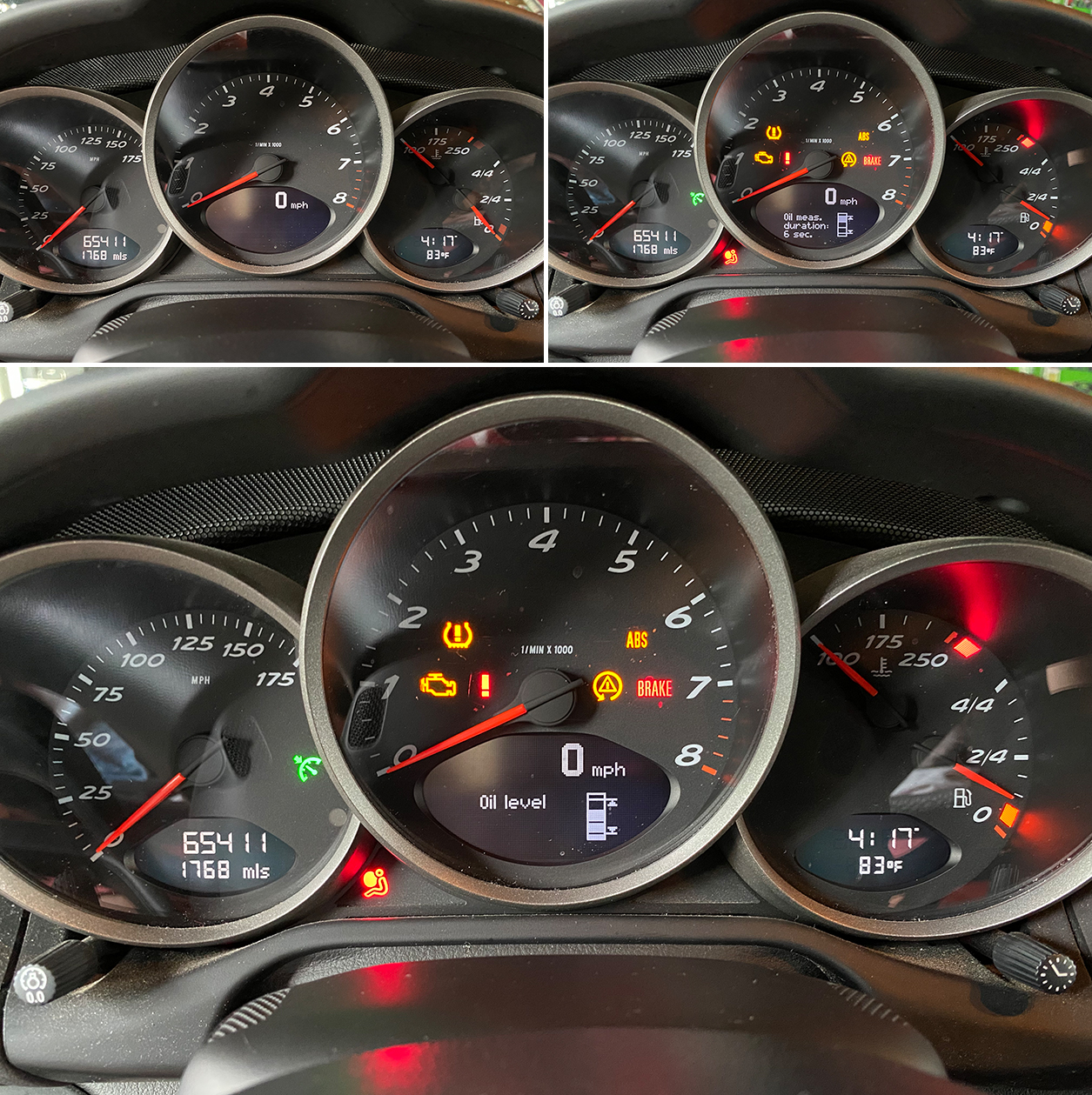How to Check Oil Level on Dashboard
To check oil level on the dashboard, locate the oil dipstick and ensure the car is on level ground. Make sure the engine is cool before pulling out the dipstick, wiping it clean, reinserting it fully, and checking the oil level.
Checking your oil level regularly is crucial to maintaining your vehicle’s engine health and performance. Proper oil levels ensure smooth operation, decrease the risk of engine damage, and prolong the lifespan of your car. By following simple steps to check your oil level, you can keep your vehicle running smoothly and avoid potential issues down the road.
Regular oil checks are a simple yet effective way to ensure your car’s optimal performance and longevity.

Credit: www.gulfoilltd.com
Importance Of Checking Oil Level
When it comes to the maintenance of a vehicle, checking the oil level is a crucial task that should never be overlooked. Maintaining Proper Oil Levels ensures the smooth functioning of the engine and prevents costly damages. In this blog post, we will discuss the importance of checking the oil level on the dashboard and the potential risks of neglecting this essential task.
Maintaining Proper Oil Levels
Regularly monitoring and maintaining the proper oil levels in your vehicle is essential to ensure the longevity and efficiency of the engine. The engine oil serves as a lubricant for the various moving parts of the engine, reducing friction and preventing wear and tear. It also helps in dissipating heat, preventing the engine from overheating. Neglecting to check and maintain the oil level can lead to a decrease in lubrication, causing increased friction and potential damage to the engine components.
Preventing Engine Damage
Checking the oil level on the dashboard is a proactive measure aimed at preventing potential engine damage. An inadequate supply of oil can result in increased friction, leading to overheating and excessive wear on engine components. This can ultimately lead to costly repairs or even engine failure. By regularly monitoring and maintaining the oil level, you can effectively prevent such scenarios and ensure the smooth operation of your vehicle’s engine.
Identifying The Oil Check Indicator
Learn how to identify the oil check indicator on your dashboard for easy oil level monitoring without the need for additional tools or equipment. Keeping an eye on this indicator can help you ensure that your vehicle’s engine is properly lubricated and running smoothly.
Knowing how to check your oil level is crucial for maintaining your car’s health. The oil check indicator, typically displayed on your car’s dashboard, alerts you when it’s time to check the oil level. This indicator is essential for preventing engine damage due to low oil levels.
Locating The Oil Check Icon
- The oil check icon is commonly shaped like an oil can or a dripping oil symbol on the dashboard.
- It is usually located near the speedometer or oil gauge in the instrument cluster.
- Refer to your vehicle’s owner’s manual for the specific location of the oil check indicator.
Understanding The Indicator’s Meaning
- When the oil check icon illuminates, it indicates that your vehicle’s oil level may be low.
- This warning should prompt you to check the oil level manually and add oil if necessary.
- Ignoring the oil check indicator can lead to engine damage, so it’s essential to address it promptly.
Steps To Check Oil Level
When it comes to maintaining your vehicle, checking the oil level is a crucial task that ensures your engine runs smoothly. Here are the simple steps to check the oil level on your dashboard:
Park The Vehicle On A Flat Surface
To start, park the car on a level surface to get an accurate oil level reading.
Locating The Oil Dipstick
Next, locate the oil dipstick under the hood of the car. It’s often brightly colored for easy identification.
Checking The Oil Level
- Pull out the dipstick and wipe it clean with a cloth or paper towel.
- Reinsert the dipstick completely and then pull it out again to view the oil level.
- Ensure that the oil level falls between the minimum and maximum markings on the dipstick.
By following these simple steps, you can easily monitor and maintain the oil level in your vehicle, ensuring optimal performance and longevity of your engine.

Credit: www.pca.org
Interpreting Oil Level Readings
When it comes to maintaining your car, checking the oil level is an essential part of keeping the engine in good condition. The oil level readings on your dashboard provide crucial information, helping you understand whether your vehicle has enough oil for proper lubrication. Here’s how you can interpret the oil level readings and understand the warning signs.
Ideal Oil Level Range
The ideal oil level range is typically indicated by two marks on the dipstick or oil level gauge. When you check the oil level on the dashboard, you should ensure that the oil level falls between these two marks, indicating that the oil level is within the recommended range for optimal engine performance.
Low Oil Level Warning Signs
If the oil level on the dashboard falls below the minimum mark, it signifies that your car has low oil. This can lead to engine damage and should be addressed immediately. Look out for warning signs such as illuminated oil pressure or low oil level indicator lights on the dashboard, abnormal engine noises, or visible oil leaks beneath your vehicle.
High Oil Level Warning Signs
On the other hand, if the oil level surpasses the maximum mark, it indicates that there is an excess of oil in the engine. This can lead to reduced engine performance and potential damage. Warning signs of high oil level may include a strong smell of burnt oil, blue smoke coming from the exhaust, or increased oil consumption beyond normal levels.
Top-up Or Change Oil
Checking the oil level on your car dashboard is an essential task to ensure the proper functioning and longevity of your engine. But what if you find that the oil level is below the optimal range? In such cases, it’s time to take action and either top-up or change the oil. In this section, we will guide you through the steps of adding oil to reach the optimal level and performing a complete oil change.
Adding Oil To Reach Optimal Level
If you notice that the oil level is below the recommended range, it’s crucial to take immediate action and top-up the oil. Here’s how you can do it:
- Make sure your engine is off and has cooled down for at least 10 minutes.
- Locate the oil filler cap under the hood of your car. It’s usually labeled with an oil can symbol.
- Remove the oil filler cap and attach a funnel securely into the opening.
- Slowly pour the recommended type and amount of oil into the funnel. Be cautious not to overfill the engine.
- Once you have reached the optimal oil level, remove the funnel and securely reattach the oil filler cap.
- Double-check the oil level on the dashboard to ensure it’s within the acceptable range.
By following these steps, you can effectively top-up your engine’s oil to the recommended level, ensuring optimal performance and protection against wear and tear.
Performing An Oil Change
Sometimes, simply adding oil may not be sufficient, especially if the existing oil is old and contaminated. In such cases, consider performing a complete oil change. Here’s what you need to do:
- Gather the necessary tools and materials for an oil change, including a wrench, oil filter wrench, a new oil filter, and the correct type and amount of oil.
- Place a drain pan under the oil drain plug, located on the bottom of the engine.
- Loosen the drain plug with a wrench and carefully remove it, allowing the old oil to drain completely into the pan.
- While the oil is draining, locate the oil filter and use an oil filter wrench to unscrew and remove it.
- Clean the area around the oil filter housing and install the new oil filter, ensuring it’s securely tightened.
- Replace the drain plug and tighten it appropriately.
- Open the hood, remove the oil filler cap, and pour the correct type and amount of oil into the engine.
- Securely reattach the oil filler cap and start the engine, allowing it to run for a few minutes to circulate the new oil.
- Lastly, check the oil level on the dashboard to ensure it’s at the optimal range.
This comprehensive oil change process will help you maintain the health of your engine by removing old, contaminated oil and replacing it with fresh oil, maximizing performance and prolonging the life of your vehicle.

Credit: m.youtube.com
Frequently Asked Questions Of How To Check Oil Level On Dashboard
Can You Check Oil Level On Dashboard?
Yes, you can check the oil level on the dashboard. It’s displayed as a warning light or gauge.
How Can I Tell If My Car Is Low On Oil?
To check if your car is low on oil, remove the dipstick, wipe it clean, then reinsert and pull it out. If the oil level is below the minimum mark, your car is low on oil.
How Do You Read The Oil Level On A Car?
To read the oil level on a car, park on level ground, wait for the engine to cool, pull out the dipstick, wipe it clean, reinsert it fully, then pull it out again to check the oil level between the “min” and “max” markings.
Do You Check Oil Level When Car Is Hot Or Cold?
Check the oil level when the car is cold for accurate reading.
Faq 1: How Do I Check The Oil Level On My Dashboard?
To check the oil level on your dashboard, locate the oil dipstick, pull it out, wipe it clean, reinsert it, and then pull it out again. The indicator on the dipstick will show you the oil level.
Faq 2: Why Is It Important To Check The Oil Level On The Dashboard?
Regularly checking the oil level on your dashboard is crucial to ensure your engine’s proper functioning. Insufficient oil can cause engine damage, while excess oil can lead to other problems.
Faq 3: How Often Should I Check The Oil Level On The Dashboard?
It is recommended to check the oil level on your dashboard at least once a month or before embarking on a long journey. Regular checks help identify any potential issues and maintain optimal engine performance.
Conclusion
In essence, regularly checking your dashboard oil level is crucial for the optimal performance and longevity of your vehicle. By following the simple steps outlined you can ensure that your engine continues to run smoothly and efficiently. With a little knowledge and attention to detail, you can navigate the process with ease, giving you peace of mind on the road.


